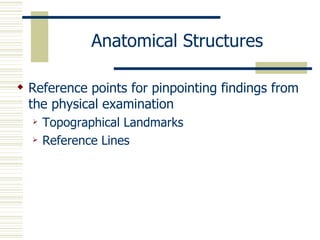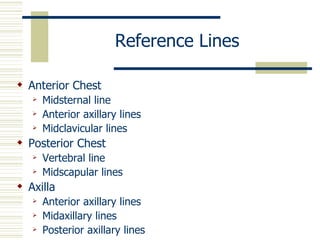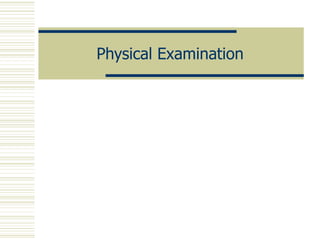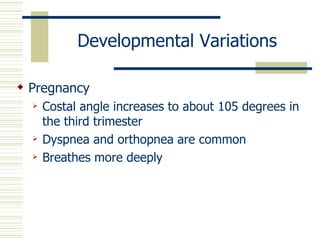Respiratory assessment
- 1. Assessment of the Chest and Lungs
- 2. Functions of the Respiratory System Ventilation Diffusion and Perfusion Control of Breathing
- 3. Functions Ventilation Movement of air into and out of the lungs Inspiratory phase Expiratory phase
- 4. Functions Hypoventilation Slow, shallow breathing Causes CO2 to build up in the blood Acidosis Hyperventilation Rapid, deep breathing Causes CO2 to be blown off Alkalosis
- 5. Functions Diffusion and Perfusion Gas exchange across the alveolar-pulmonary capillary membranes Control of breathing Influenced by neural and chemical factors Pons, medulla, chemoreceptors in the carotid body Stimulus for breathing Increased carbon dioxide - PRIMARY
- 6. Anatomical Structures Reference points for pinpointing findings from the physical examination Topographical Landmarks Reference Lines
- 7. Topographical Landmarks Nipples Manubriosternal junction (Angle of Louis) Point at which the 2nd rib articulates with the sternum Suprasternal notch Costal Angle Usually no more than 90 degrees Ribs insert at approximately 45 degree angles Clavicles
- 8. Manubrium Manubriosternal junction (Angle of Louis) Nipple Costal Angle
- 9. Reference Lines Anterior Chest Midsternal line Anterior axillary lines Midclavicular lines Posterior Chest Vertebral line Midscapular lines Axilla Anterior axillary lines Midaxillary lines Posterior axillary lines
- 10. Anterior Chest
- 11. Posterior Chest
- 12. Axilla
- 13. Anatomy
- 14. Anatomy Points to Remember Lungs are symmetric Lungs are divided into lobes Right lung = 3 lobes Left lung = 2 lobes Primary muscles of respiration Diaphragm – divides chest from abdomen External intercostal muscles Accessory muscles
- 15. Anatomy Points to Remember Upper Airway Nose, pharynx, larynx, intrathoracic trachea Functions in respiration Conduct air to lower airway Filter to protect lower airway Warm and humidify inspired air
- 16. Anatomy Points to Remember Lower Airway Trachea, bronchi, bronchioles Functions in respiration Conduct air to alveoli Clear mucociliary structures Alveoli Functional unit Gas exchange Production of surfactant
- 17. Anatomy Points to Remember Lower Airway Trachea splits into left and right mainstem bronchi which are further subdivided into bronchioles Right bronchus is shorted, wider and more upright than the left Functions in respiration Conduct air to alveoli Clear mucociliary structures
- 22. Chest Anatomy Web Anatomy: http://www.gen.umn.edu/faculty_staff/jensen /1135/webanatomy/
- 23. History Chief Complaint and HPI Cough Shortness of breath/Dyspnea
- 24. Cough Onset – sudden, gradual Duration Nature – dry, moist, hacking, barking Sputum – amount, color, odor Severity – disrupts activities Associated symptoms – sneezing, dyspnea, fever, chills, congestion, gagging What brings it on? – anxiety, talking, activity What makes it better? What has been tried? – medications, treatments Anything similar in the past?
- 25. Shortness of Breath (SOB) / Dyspnea Onset – sudden, gradual Duration Severity – disrupts activities Associated symptoms – night sweats, pain, chest pressure, discomfort, ankle edema, diaphoresis, cyanosis What brings it on? – position, time of day, exercise, allergens, emotions What makes it better? What has been tried? – medications, inhalers, oxygen Anything similar in the past?
- 26. History Past Health History Lung disease or breathing problems Frequent severe colds, asthma, emphysema, bronchitis, pneumonia, tuberculosis Last PPD and/or chest x-ray Allergies Medication use Family History
- 27. History Personal and Social History Tobacco Alcohol Drugs Home environment Occupational environment Travel Health Promotional Activities
- 29. Equipment and Techniques Equipment Stethoscope Techniques Inspection Palpation Percussion Auscultation
- 30. Inspection General Appearance Posturing Breathing effort Trachea position Midline
- 31. Inspection Chest Wall Configuration Form Symmetry Muscle development Anterior-Posterior (AP) diameter Approximately ½ the transverse diameter Transverse: Anterior-Posterior = 2:1 Costal angle 90 degrees or less
- 32. Inspection Oxygenation: cyanosis Nails Skin Lips Respiratory Effort Respiratory rate and depth Breathing pattern Chest expansion
- 33. Palpation Trachea – for position Chest wall – for symmetry
- 34. Palpation Thoracic Expansion (Excursion) Place both thumbs at about 7th rib posteriorly along the spinal process Click on the pictures to view video Extend the fingers of both hands outward over the posterior chest wall Have the person take a deep breath and observe for bilateral outward movement of thumbs Normal: bilateral, symmetric expansion Abnormal: unilateral or unequal
- 35. Palpation Vocal (Tactile) Fremitus Use palmar or ulnar surfaces of hands Systematically position hands over both sides of posterior chest Have person repeat “1 – 2 – 3” or “99” as you move from the apices to the bases Normal: bilaterally symmetrical vibrations Decreased or absent: obstruction of transmission 0bronchitis, emphysema) Increased: consolidation (compression) of lung tissue (pneumonia)
- 36. Auscultation Auscultate in a systematic manner Compare one side to the other Listen one full respiration at each spot Displace breast tissue to listen directly over chest wall DO NOT listen through gowns, clothes, etc. Place your stethoscope over bare skin
- 37. Auscultation Evaluate posterior, lateral, and anterior chest Instruct person to sit upright and breathe in and out slowly through the mouth This makes it easier to hear the air movement Use the diaphragm of the stethoscope Move from the apices to the bases
- 38. Auscultation Evaluate for normal sounds Sound Pitch Intensity Quality I:E Location Bronchial High Loud Blowing/ I<E Trachea hollow Bronchovesicular Moderate Moderate Combination I=E Between scapulae, 1st & 2nd ICS lateral to sternum Vesicular Low Soft Gentle rustling/ I>E Peripheral lung breezy
- 39. Auscultation Evaluate for adventitious sounds Sound Intensity/ Pitch I/E Quality Clear with Cough Crackles/ Soft (fine)/ High I Discontinuous, Possibly Rales Loud (coarse)/ Low nonmusical, brief Wheeze High E Continuous musical Possibly sounds Ronchi Low E Continuous snoring Possibly sounds Pleural I&E Continuous or Never Friction Rub discontinuous creaking or brushing sounds Stridor I Continuous, crowing Never
- 40. Auscultation Copy this URL into your Web browser to hear normal and abnormal lung sounds : http://medocs.ucdavis.edu/IMD/420C/sounds/lngsound.htm
- 41. Developmental Variations Neonates Measure the chest circumference Usually 2-3 cm smaller than head circumference Chest is round (i.e. AP diameter = transverse) Obligate nose breathers Periodic breathing is common Sequence of vigorous breathing followed by apnea for 10-15 seconds Only concern if it is prolonged or baby becomes cyanotic
- 42. Developmental Variations Neonates Breathing is diaphragmatic and abdominal Signs of compromise Stridor (“crowing”) Grunting Central cyanosis Flaring nares
- 43. Developmental Variations Infants and Young Children Roundness of the chest persist for first 2 years Chest walls are thinner than the adult’s Breath sounds may sound louder, and more bronchial than the adult Bronchovesicular sounds may be heard throughout the chest
- 44. Developmental Variations Pregnancy Costal angle increases to about 105 degrees in the third trimester Dyspnea and orthopnea are common Breathes more deeply
- 45. Developmental Variations Older Adult Chest expansion is often decreased Bony prominences are marked AP diameter is increased with respect to transverse (but not 1:1)
- 46. Videos of Thorax and Lung Assessment Copy these URLs into your Web browser http://www.conntutorials.com/chapter5.html OR http://medinfo.ufl.edu/other/opeta/chest/CH_main













































